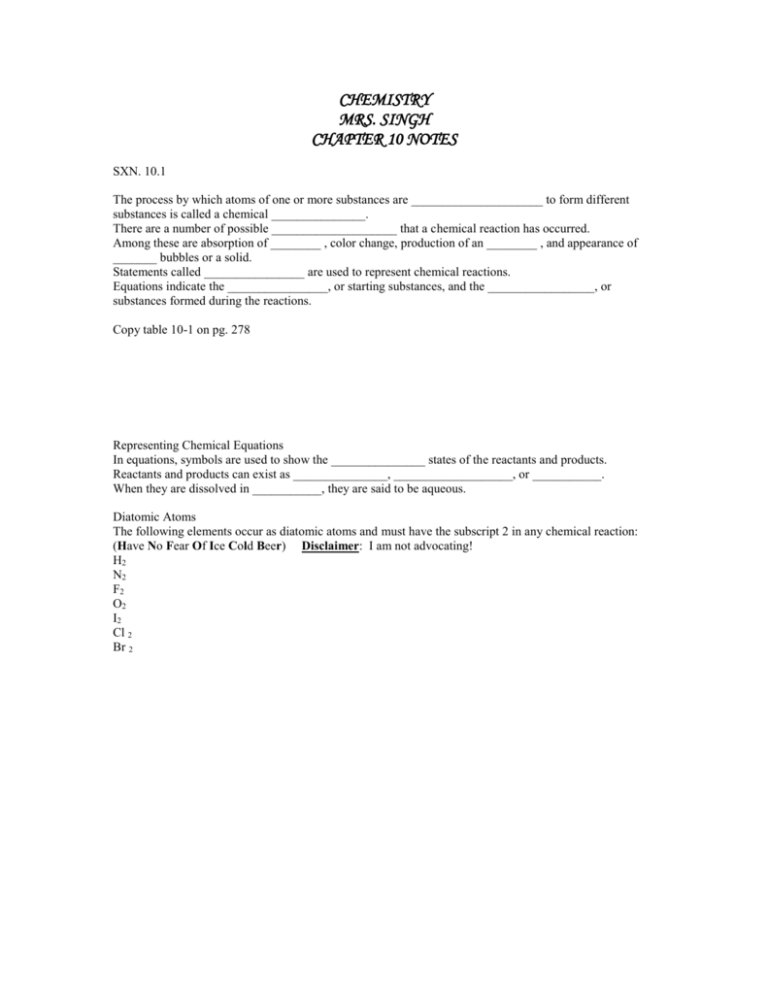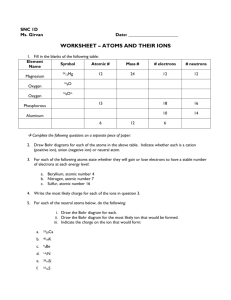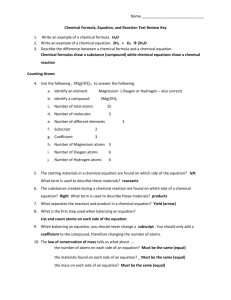CHEMISTRY
advertisement

CHEMISTRY MRS. SINGH CHAPTER 10 NOTES SXN. 10.1 The process by which atoms of one or more substances are _____________________ to form different substances is called a chemical _______________. There are a number of possible ____________________ that a chemical reaction has occurred. Among these are absorption of ________ , color change, production of an ________ , and appearance of _______ bubbles or a solid. Statements called ________________ are used to represent chemical reactions. Equations indicate the ________________, or starting substances, and the _________________, or substances formed during the reactions. Copy table 10-1 on pg. 278 Representing Chemical Equations In equations, symbols are used to show the _______________ states of the reactants and products. Reactants and products can exist as _______________, ___________________, or ___________. When they are dissolved in ___________, they are said to be aqueous. Diatomic Atoms The following elements occur as diatomic atoms and must have the subscript 2 in any chemical reaction: (Have No Fear Of Ice Cold Beer) Disclaimer: I am not advocating! H2 N2 F2 O2 I2 Cl 2 Br 2 Chemistry Rules for Balancing Equations A. Write the Correct Formulas - (for the reactants and products) B. 1. Reactants are what you start with; products are what you end up with. Reactants are to the left of the arrow (yields or produces) sign; products are to the right of the arrow. 2 Remember that seven elements are diatomic. This means the smallest part you can have when they stand alone (as an element rather than as a compound) is two atoms. Memorize this list. Balance by Placing Coefficients in Front of the Formula 1. C. Never change the subscripts once you have the correct formulas. Again, to repeat: NEVER CHANGE THE FORMULAS! Let’s See an Example 1. magnesium and oxygen Mg + 1 atom of magnesium + O2 2 atoms oxygen magnesium oxide produces MgO 1 atom of magnesium 1 atom of oxygen 2. Count the atoms of each element on both sides of the equation. You can see that you have two atoms of oxygen on the left side (going into the reaction), and only one atom of oxygen on the right side (coming out of the reaction). 3. You must put another oxygen atom on the right, but you can not change the formula. You can not write MgO2 since that would not add up to the number of electrons exchanged (MgO2 is not magnesium oxide). 4. So go back to rule #2 and put a coefficient 2 in front of MgO. Mg + O2 2 MgO 5. The coefficient means there is two of everything following it. So, by placing the coefficient there, the number of oxygen atoms are balanced, but the number of magnesium no longer balance. We now have one magnesium atom on the left, and two on the right. If we put a coefficient 2 in front of Mg on the left side, these atoms will then balance. 2 Mg + O2 2 MgO We now have two magnesium atoms on the left and two on the right. We also have two oxygen atoms on the left and two on the right. Types of Chemical Reactions 1. Synthesis Reactions - A + B AB A. The term ‘synthesis’ means to make or to build. B. Synthesis reactions are also referred to as ‘Composition’ reactions. B. In synthesis reactions two or more elements and/or compounds are being put together to form one larger compound. 2. Decomposition Reactions - AB A + B A. In decomposition reactions one large molecule is broken down into two or more elements and/or compounds. 3. Single Displacement Reactions - X + AB XB + A A. In single displacement reactions an element and a compound react to form a different element and a different compound. B. The element will displace one of the ions in the compound. That ion then becomes the new element in the product. C. The ion in the compound that is displaced depends on the type of ion the element will become. 1) If the element becomes a positive ion, then it will displace the positive ion in the compound and bond with the negative ion. X + AB XB + A 2) If the element becomes a negative ion, then it will displace the negative ion in the compound and bond with the positive ion. X + AB AX + B 4. Double Displacement Reactions - AX + BY AY + BX A. In double displacement reactions two compounds react to form two different compounds. B. Positive ions ALWAYS bond with negative ions. Positive ions NEVER bond with other positive ions, and negative ions NEVER bond with other negative ions. C. The positive ion is ALWAYS written first. We always write NaCl, never ClNa, 5. Combustion Reactions - CXHY + O2 CO2 + H2O A. In combustion reactions hydrocarbons are burned (combined with oxygen gas). Hydrocarbons are compounds that contain ONLY carbon and hydrogen. B. The products are ALWAYS the same – carbon dioxide and water. Ms. Singh’s Handy Hints 1. When you have an element split between two formulas on the same side of the equation, balance it last. 2. When you have an even number of atoms on one side of the equation and an odd number of atoms of the same element on the other side, make the odd one even. 3. When you have 3 atoms of an element on one side of the equation and 2 atoms on the other, make them 6 (lowest common multiple) by multiplying the 2-atoms by 3 and the 3-atoms by 2. Usually you just place these numbers as coefficients.






